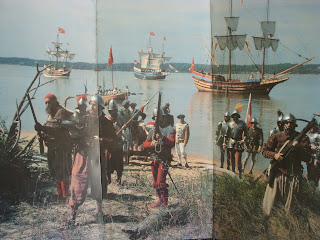At the DeSoto National Park we sat in on a presentation by a fellow in period dress, during which he fired off a musket. And told us:
- The firing of a musket has 3 elements, the first being powder in "the pan" that is ignited by the "lock", setting off round 2 (can't remember, probably a firing mechanism) that ignites the powder in the barrel. Sometimes the pan powder does little more than flash, thus creating a "flash in the pan."
- A musket is made by three manufacturers, a locksmith, a wood smith, and an iron worker, who make, respectively, the lock, the stock, and the barrel. Thus when the gun is fully assembled it is "lock, stock, and barrel!"
The photo is a panorama display of DeSoto "coming ashore" when he did.
At Gamble Plantation, once a slave plantation:
- Old rope beds included a mattress lying on a rope frame. As the ropes stretched over time, the owner or his slave would utilize a wooden post at the foot of the bed to which the ropes were tied, and a hole drilled through the post atone end. A rod would be inserted into the hole to act as a crank. Spinning the post to tighten the ropes would enable a person to "sleep tight."
- A bathtub was seldom used more than once a week, need it or not, and since carrying the hot water to its location was difficult, the entire family would use the same water, husband first, then wife, oldest child, and so on, down to the baby. Thus, when finished, all were warned to be careful not to "throw out the baby with the bathwater."
Plantation mansions were typically 2 separate buildings with a common roof, the second building added as wealth was generating, and the first then used primarily as working quarters for upper tier slaves. The space between the two buildings was used, among other things, as a walkway for the slave boys to carry and deliver food at mealtime. Dogs also tended to concentrate here, especially at mealtime, since the kitchen was located on this walkway, in the slave quarters.
- The walkway between buildings was known as a "whistle walk" because the slave boys were required to whistle while delivering the food, to prevent them from eating/tasting the food.
- To keep the dogs away, the slaves cooking would would deep fry cornbread then thrown out to the dogs to keep them quiet, thus earning the name of "hush puppies."
A missed opportunity - a young black family joined the tour shortly before it started, and left before I had a chance to visit with them. As we walked about and stories were told I couldn't help but wonder what was going through their heads, especially the parents, who were nicely dressed, so presumably were earning a good income. It had to be bittersweet.

No comments:
Post a Comment